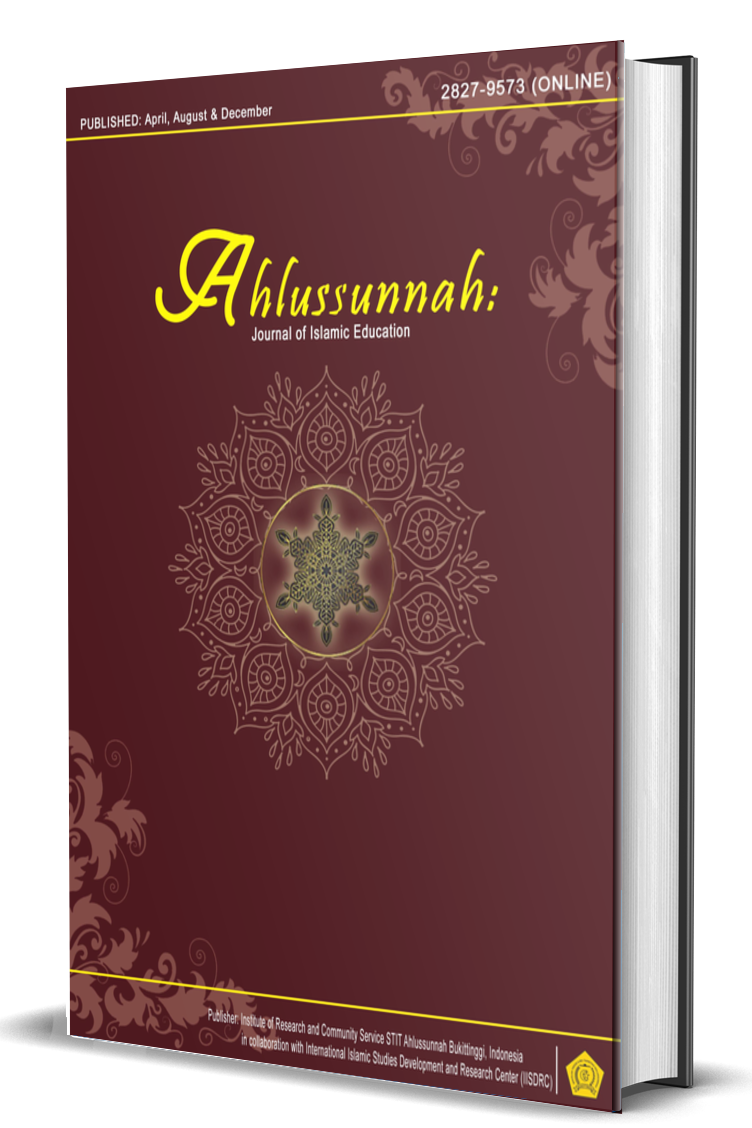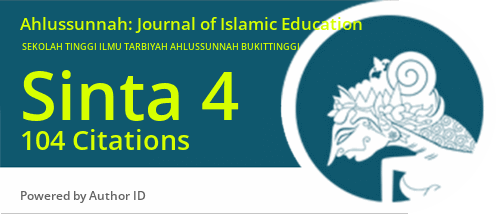Effectiveness of Student Online Learning in Indonesia
DOI:
https://doi.org/10.58485/jie.v2i3.181Keywords:
Efektivitas, students, electronic learning, pandemicAbstract
The breakdown of parents' concentration and various new problems in the Lima Rakyat community regarding the teaching and learning process during Covid 19 which was regulated by several schools and madrasas in the Lima Kunci sub-district have raised parents' concerns about their children's education. This research aims to overcome learning problems during the Covid 19 pandemic, especially in the five Batusangkar communities so that ideal education can be achieved by balancing government regulations regarding the pandemic with effective and efficient learning process standards for students. This type of research is descriptive qualitative, describing the learning process during the pandemic, identifying all learning problems in the field by interviewing students and relevant to school policies to maintain the quality of the teaching and learning process. Research findings on the effectiveness of online learning have given rise to a new polemic in five Batusangkar communities where the limited facilities and infrastructure in the technology sector and the weak economy of the community to buy internet quotas and android cellphones as well as a limited signal in rural areas, apart from economic constraints and study concentration, new problems have emerged, namely controlling online learning is difficult for parents to do because parents' lack of technology results in children wandering around playing online games and doing and using android only as a game application that is not useful so that online learning is not carried out well because android is often used for things that are not useful. useful and the occurrence of online gambling, opening adult sites, and creating negative WhatsApp groups. Ideally, school policy is recommended in providing assignments in online learning and increasing parental control in online learning in order to create effective and efficient learning. The research results can be used as initial data for subsequent researchers to study this problem in the context of different issues and findings.
Downloads
References
Achimugu, P., Selamat, A., Ibrahim, R., & Mahrin, M. N. R. (2014). A systematic literature review of software requirements prioritization research. Information and Software Technology, 56(6), 568–585. https://doi.org/10.1016/j.infsof.2014.02.001
Billieux, J., Van Der Linden, M., Achab, S., Khazaal, Y., Paraskevopoulos, L., Zullino, D., & Thorens, G. (2013). Why do you play World of Warcraft? An in-depth exploration of self-reported motivations to play online and in-game behaviours in the virtual world of Azeroth. Computers in Human Behavior, 29(1), 103–109. https://doi.org/10.1016/j.chb.2012.07.021
Boling, E. C., Hough, M., Krinsky, H., Saleem, H., & Stevens, M. (2012). Cutting the distance in distance education: Perspectives on what promotes positive, online learning experiences. Internet and Higher Education, 15(2), 118–126. https://doi.org/10.1016/j.iheduc.2011.11.006
Bryson, J. R., Andres, L., & Davies, A. (2020). COVID-19, Virtual Church Services and a New Temporary Geography of Home. Tijdschrift Voor Economische En Sociale Geografie, 111(3), 360–372. https://doi.org/10.1111/tesg.12436
Colorafi, K. J., & Evans, B. (2016). Qualitative Descriptive Methods in Health Science Research. Health Environments Research and Design Journal, 9(4), 16–25. https://doi.org/10.1177/1937586715614171
Correa, J. M., Martínez-Arbelaiz, A., & Aberasturi-Apraiz, E. (2015). Post-modern reality shock: Beginning teachers as sojourners in communities of practice. Teaching and Teacher Education, 48, 66–74. https://doi.org/10.1016/j.tate.2015.02.007
Demuyakor, J. (2020). Coronavirus (Covid-19) and online learning in higher institutions of education: A survey of the perceptions of ghanaian international students in China. Online Journal of Communication and Media Technologies, 10(3). https://doi.org/10.29333/ojcmt/8286
Dhawan, S. (2020). Online Learning: A Panacea in the Time of COVID-19 Crisis. Journal of Educational Technology Systems, 49(1), 5–22. https://doi.org/10.1177/0047239520934018
Dormann, C. F., Elith, J., Bacher, S., Buchmann, C., Carl, G., Carré, G., Marquéz, J. R. G., Gruber, B., Lafourcade, B., Leitão, P. J., Münkemüller, T., Mcclean, C., Osborne, P. E., Reineking, B., Schröder, B., Skidmore, A. K., Zurell, D., & Lautenbach, S. (2013). Collinearity: A review of methods to deal with it and a simulation study evaluating their performance. Ecography, 36(1), 27–46. https://doi.org/10.1111/j.1600-0587.2012.07348.x
Febriani, S. R., Safutri, J. T., Yusnawati, Y., & Anasrudin, A. (2020). Development of Literacy in Islamic Education in the COVID-19 Pandemic Era for Elementary School. Khalifa: Journal of Islamic Education, 4(2), 79. https://doi.org/10.24036/kjie.v4i2.44
Ferri, F., Grifoni, P., & Guzzo, T. (2020). Online learning and emergency remote teaching: Opportunities and challenges in emergency situations. Societies, 10(4). https://doi.org/10.3390/soc10040086
Ghosh, A., Gupta, R., & Misra, A. (2020). Telemedicine for diabetes care in India during COVID19 pandemic and national lockdown period: Guidelines for physicians. Diabetes and Metabolic Syndrome: Clinical Research and Reviews, 14(4), 273–276. https://doi.org/10.1016/j.dsx.2020.04.001
Gonzalez, T., De la Rubia, M. A., Hincz, K. P., Comas-Lopez, M., Subirats, L., Fort, S., & Sacha, G. M. (2020). Influence of COVID-19 confinement on students’ performance in higher education. PLoS ONE, 15(10 October). https://doi.org/10.1371/journal.pone.0239490
Hew, K. F., & Cheung, W. S. (2014). Students’ and instructors’ use of massive open online courses (MOOCs): Motivations and challenges. Educational Research Review, 12, 45–58. https://doi.org/10.1016/j.edurev.2014.05.001
Islam, A. K. M. N. (2013). Investigating e-learning system usage outcomes in the university context. Computers and Education, 69, 387–399. https://doi.org/10.1016/j.compedu.2013.07.037
Joshua, J. N., Swastika, I. P. A., & Estiyanti, N. M. (2016). The Effectiveness of E-Learning Implementation Using Social Learning Network Schoology on Motivation & Learning Achievement. Jurnal Nasional Pendidikan Teknik Informatika (JANAPATI), 5(1), 28. https://doi.org/10.23887/janapati.v5i1.9914
Kizilcec, R. F., Pérez-Sanagustín, M., & Maldonado, J. J. (2017). Self-regulated learning strategies predict learner behavior and goal attainment in Massive Open Online Courses. Computers and Education, 104, 18–33. https://doi.org/10.1016/j.compedu.2016.10.001
Klar, H. W., & Brewer, C. A. (2013). Successful Leadership in High-Needs Schools: An Examination of Core Leadership Practices Enacted in Challenging Contexts. Educational Administration Quarterly, 49(5), 768–808. https://doi.org/10.1177/0013161X13482577
Nawrot, I., & Doucet, A. (2014). Building engagement for MOOC students: Introducing support for time management on online learning platforms. WWW 2014 Companion - Proceedings of the 23rd International Conference on World Wide Web, 1077–1082. https://doi.org/10.1145/2567948.2580054
Patricia Aguilera-Hermida, A. (2020). College students’ use and acceptance of emergency online learning due to COVID-19. International Journal of Educational Research Open, 1. https://doi.org/10.1016/j.ijedro.2020.100011
Pei, L., & Wu, H. (2019). Does online learning work better than offline learning in undergraduate medical education? A systematic review and meta-analysis. Medical Education Online, 24(1). https://doi.org/10.1080/10872981.2019.1666538
Pregowska, A., Masztalerz, K., Garlińska, M., & Osial, M. (2021). A worldwide journey through distance education—from the post office to virtual, augmented and mixed realities, and education during the covid-19 pandemic. Education Sciences, 11(3). https://doi.org/10.3390/educsci11030118
Rambe, P., & Bere, A. (2013). Using mobile instant messaging to leverage learner participation and transform pedagogy at a South African University of Technology. British Journal of Educational Technology, 44(4), 544–561. https://doi.org/10.1111/bjet.12057
Rashid, T., & Asghar, H. M. (2016). Technology use, self-directed learning, student engagement and academic performance: Examining the interrelations. Computers in Human Behavior, 63, 604–612. https://doi.org/10.1016/j.chb.2016.05.084
Sanyaolu, A., Okorie, C., Hosein, Z., Patidar, R., Desai, P., Prakash, S., Jaferi, U., Mangat, J., & Marinkovic, A. (2021). Global Pandemicity of COVID-19: Situation Report as of June 9, 2020. Infectious Diseases: Research and Treatment, 14, 117863372199126. https://doi.org/10.1177/1178633721991260
Sartika, F., Ritonga, M., & Rasyid, A. (2020). Implementation of Islamic Religious Education in Madrasah Ibtidaiyah During Covid-19 Pandemic. Khalifa: Journal of Islamic Education, 4(2), 97. https://doi.org/10.24036/kjie.v4i2.95
Sihombing, A. A., & Fatra, M. (2021). Distance Learning During the Pandemic Era: Online Learning Experiences of State Madrasah Tsanawiyah Students During Covid-19 in Indonesia. Analisa: Journal of Social Science and Religion, 6(01), 95–112. https://doi.org/10.18784/analisa.v6i01.1235
Summers, J. O. (2019). Guidelines for Conducting Research and Publishing in Marketing: From Conceptualization Through the Review Process. How to Get Published in the Best Marketing Journals. https://doi.org/10.4337/9781788113700.00011
Suryawati, E., & Osman, K. (2018). Contextual learning: Innovative approach towards the development of students’ scientific attitude and natural science performance. Eurasia Journal of Mathematics, Science and Technology Education, 14(1), 61–76. https://doi.org/10.12973/ejmste/79329
Syarif, M., & Moenada, M. S. (2020). Boarding School (Pesantren) Education During Covid-19 Pandemic at Dar El Hikmah Pekanbaru Indonesia. Khalifa: Journal of Islamic Education, 4(2), 161. https://doi.org/10.24036/kjie.v4i2.54
Tandon, H., Ranjan, P., Chakraborty, T., & Suhag, V. (2022). Coronavirus (COVID-19): ARIMA-based Time-series Analysis to Forecast near Future and the Effect of School Reopening in India. Journal of Health Management, 24(3), 373–388. https://doi.org/10.1177/09720634221109087
Tormala, Z. L., & Rucker, D. D. (2018). Attitude certainty: Antecedents, consequences, and new directions. Consumer Psychology Review, 1(1), 72–89. https://doi.org/10.1002/arcp.1004
Yang, H. H. (2013). New World, New Learning: Trends and Issues of E-Learning. Procedia - Social and Behavioral Sciences, 77, 429–442. https://doi.org/10.1016/j.sbspro.2013.03.098
Yuslia, D., Hasnah, H., Safarudin, R., & Helfikri, H. (2021). The Effectiveness of The Picture and Picture Learning Model in Improving Student Learning Outcomes In Elementary Schools. Khalifa: Journal of Islamic Education, 5(1), 80. https://doi.org/10.24036/kjie.v5i1.33
Downloads
Published
How to Cite
Issue
Section
License
Copyright (c) 2024 Muhammad Hafizh; Zainal Asril

This work is licensed under a Creative Commons Attribution-ShareAlike 4.0 International License.
Creative Commons Attribution 4.0 (CC BY)











